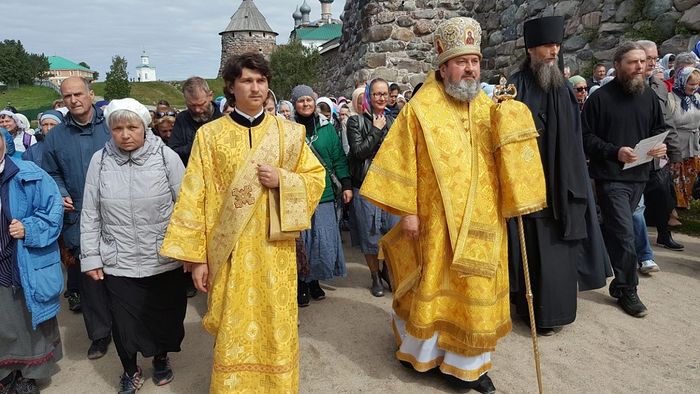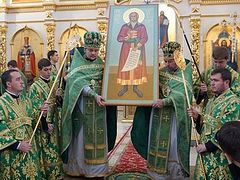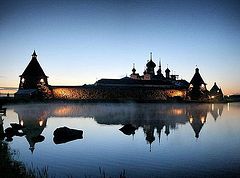Solovki Islands, June 30, 2019
His Eminence, Metropolitan Ioann of Kherson and Taurida venerated the blessed memory of the righteous Petro Kalnyshevsky, the final Hetman of the Zaporozhian host at Solovki monastery.
On June 30, 2019, Metropolitan Ioann made a pilgrimage to the Transfiguration Monastery on the Solovki islands, where he led a divine liturgy in Trinity Cathedral as the website of the Kherson diocese reports. After the service there was a cross procession around the monastery.
A video clip of the festivities on Solovki can be found here.
After the procession, Metropolitan Ioann came to the grave of the final Koshovy Ataman of the Zaporozhian Cossack Sich, Petro Kalnyshevsky (1691-1803+), who was canonized by the Ukrainian Orthodox Church on November 13, 20151.
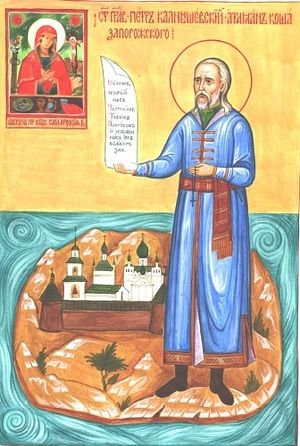 Petro Kalnyshevsky at Solovki island Petro Kalnyshevsky is a very interesting saint, and an excellent example for our times. The Righteous Petro was the final ataman, or commander of the Zaporozhian Cossack Host, which under Hetman Bogdan Khmelnitsky fought a war of independence against Poland and reunited the Ukrainian lands with Russia.
Petro Kalnyshevsky at Solovki island Petro Kalnyshevsky is a very interesting saint, and an excellent example for our times. The Righteous Petro was the final ataman, or commander of the Zaporozhian Cossack Host, which under Hetman Bogdan Khmelnitsky fought a war of independence against Poland and reunited the Ukrainian lands with Russia.
Prior to Kalnyshevsky, Hetman Ivan Mazepa broke his oath with the Russian Emperor, and fought with the invading Swedish forces in a fratricidal war which pitted Cossack against Cossack. The Russian army and Russian-allied Cossacks were victorious at the Battle of Poltava, near the later birthplace of Nikolai Gogol, and eventually where Saint John of Shanghai would complete military academy in his youth.
By the times of Kalnyshevsky however, politics and the world had changed. Cossacks who traditionally lived on the borderland, much like the American pioneers on the south western frontier, slowly encountered the encroachment of civilization on what was once wilderness.
When Kalnyshevsky was Ataman, Empress Catherine the Great ordered the Sich finally be dismantled, essentially meaning the end of Cossack autonomy in the so-called Wild Fields of modern-day southern Ukraine. This was incredibly hard for Kalnyshevsky, but it was especially his actions in those days that outlined his saintliness.
Even though he did nothing wrong, he was now a politically inconvenient character, meaning no matter what he would do, he would most likely face some repressions. In this moment, some people would flee abroad, or potentially even fight, but Kalnyshevsky refused to spill brotherly blood even for his own freedom.
Saint Petro ensured his troops would not riot, preventing the start of a civil war, at the loss of his own freedom, as he was sent into exile by the Empress at Solovki monastery.
It was there, his monastic podvig began, and decades later, even when the new Emperor finally released him from imprisonment, he chose to remain in the monastery. The saint reposed in the Lord at over 112 years of age.
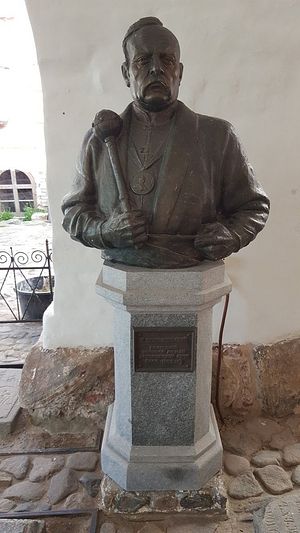 The memorial to Saint Petro where he spent the last years of his incredibly long life. Solovki Monastery, Northern Russia. Photo: pravoslavie.ks.ua Kalnyshevsky’s sacrifice allowed the Cossacks to once again fight for Russia and Orthodoxy another day, and even if the Zaporozhian Sich, the original home of Cossackdom, was gone, and the Cossacks were scattered, providence would allow them to survive, and establish new Cossack hosts in the Kuban, Don, Terek lands.
The memorial to Saint Petro where he spent the last years of his incredibly long life. Solovki Monastery, Northern Russia. Photo: pravoslavie.ks.ua Kalnyshevsky’s sacrifice allowed the Cossacks to once again fight for Russia and Orthodoxy another day, and even if the Zaporozhian Sich, the original home of Cossackdom, was gone, and the Cossacks were scattered, providence would allow them to survive, and establish new Cossack hosts in the Kuban, Don, Terek lands.
The Righteous Petro is reminiscent of Saints Boris and Gleb, who also willingly surrendered all earthly power and their own lives, rather than fight and risk a fratricidal war. This is the true reason Orthodox warrior saints are often canonized, for conquering the legions of pride and iniquity in their own hearts, and inspiring others to do the same, rather than for defeating any earthly enemies.
Metropolitan Luke of Zaporozhye called upon the modern descendants of those Cossacks, his flock in Ukraine, to remember and not dishonor the memory of the Cossacks as glorious knights, and defenders of Orthodoxy in times of schism.
His Eminence, Metropolitan Luke wrote a powerful open letter to Patriarch Bartholomew, which began “Dear loyal subject of the Turkish Republic”, which is certainly true to the Cossack tradition of boldly worded letters.
Just recently, on Tuesday, we reported that a competition entitled, “We are the heirs of the Saints of Zaporozhye” was opened in the Zaporozhye diocese, the purpose of which is to increase awareness and veneration of those amazing Saints.
We are also happy to report that prior to that, here at Orthochristian.com, we have presented the first English language translation of the lives of those remarkable saints, in an article entitled “Zaporozhye the Unconquered, The Glorious Lives of the New Martyrs and Confessors of the Wild Cossack Fields”.
Matfey Shaheen

